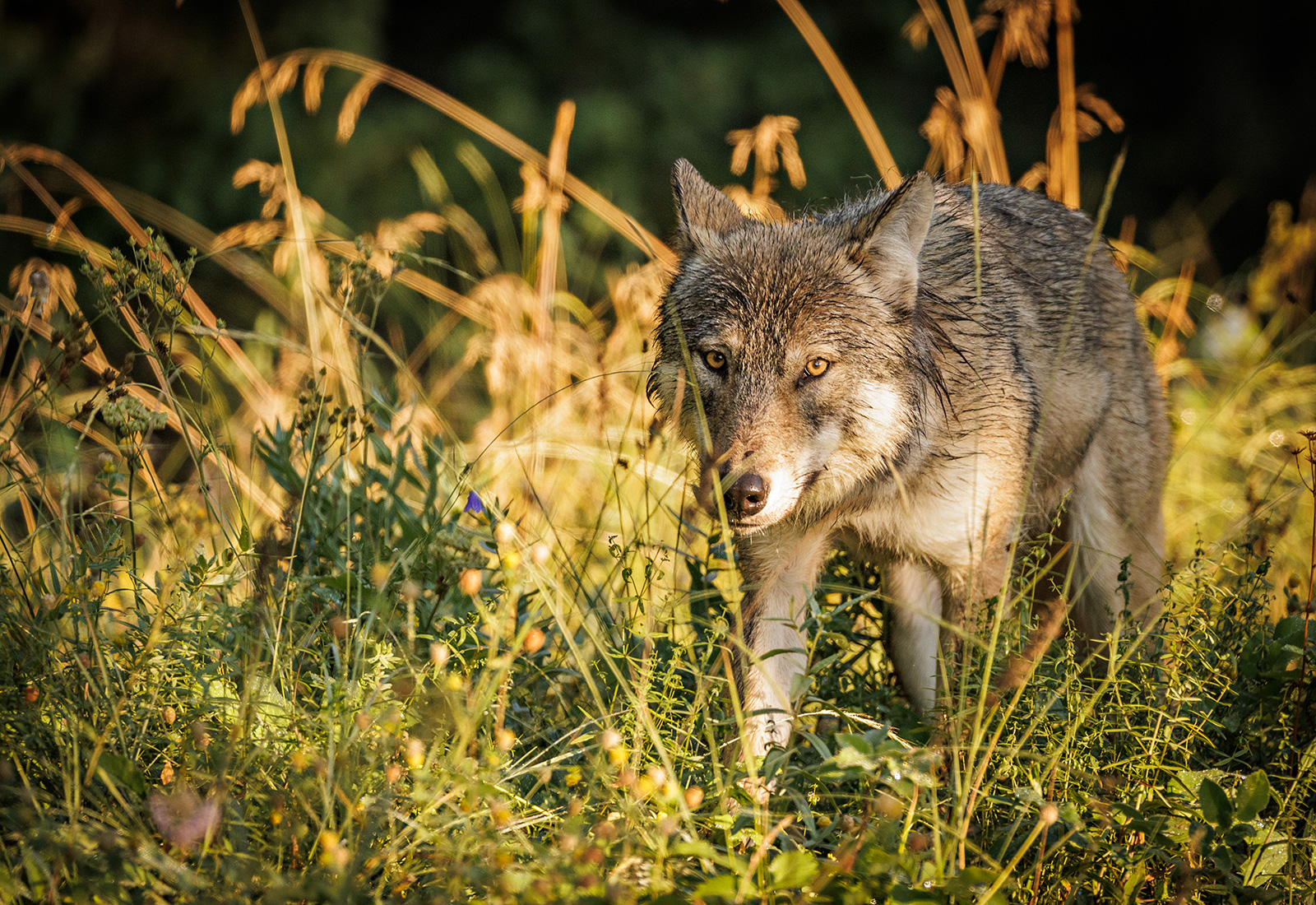FWP Releases Draft of New Wolf Conservation and Management Plan
The agency incorporated up-to-date science in its proposed management of the state’s roughly 1,100 wolves, but the draft plan has generated pushback from conservationists concerned about ambiguous wording and a lack of public input
By Anusha Mathur
Despite their generally shy and elusive nature, in recent years gray wolves have frequently found themselves at the center of controversy and litigation in Montana. As conflicts about species conservation and management fuel politicized debate, stakeholders have vastly different visions about what proper wolf population management should look like in the state.
Montana Fish, Wildlife and Parks (FWP) released a draft of their 2023 Gray Wolf Conservation and Management Plan last week, the first update in 20 years, to guide future wolf management policy. The department is currently accepting comments to incorporate public perspectives as they finalize the document. They will not, however, be creating an advisory committee with representatives of stakeholder groups.
Wildlife conservation groups say they are “appalled” by the new plan, calling it an aggressive blow and targeted assault on wolves, especially in the wake of a series of administrative policies designed to increase opportunities for wolf harvesting. They demand that the department’s final version of the plan outline increased ways to protect Montana’s existing wolf population.
When officially instituted, the new conservation and management plan will replace the state’s prior strategy published in 2003. The document incorporates new scientific methodology and includes historical data about interspecies dynamics as well as wolves’ impact on Montana’s landscape. FWP said the department’s substantial experience in wolf management allowed them to outline holistic and effective strategies.
“New and improved research, tools and monitoring methods have been developed and incorporated into how we manage our gray wolves,” said Greg Lemon, FWP Communication and Education Division administrator. “The plan is guiding us in a management direction to get to a sweet spot where we have low numbers of conflict, deer and elk numbers rebounding and flexibility to deal with isolated conflict incidents when they occur.”
Gray wolves were delisted from the endangered species act in 2011 and have since been managed under state authority. FWP reports that from 2011-2022, the population has largely stabilized with an average of 194 packs and 1,165 wolves per year.
The 2023 management plan will not directly implement new policy; instead, it will serve as a key document that the Fish and Wildlife Commission considers as its members outline future regulations including hunting, trapping, and conservation.
Another key difference between the 2003 and 2023 plans is a shift in the metrics used to monitor and quantify healthy wolf populations.
“After lots of study of wolf dynamics, we know that to ensure 15 breeding pairs, which was set as the benchmark for delisting, it takes about 450 wolves on the landscape,” Lemon said. “Our focus is not going to be on tracking breeding pairs, but looking at numbers of wolves, which has kind of been our shift over the years anyway. It really does lend itself to a more accurate way of looking at the wolf population.”
The baseline of “450 wolves” has generated controversy since the plan’s release, especially among conservationists who point out that this would constitute a 60% reduction in the number of animals on the landscape. Lemon said the controversy is rooted in misconception, clarifying that 450 wolves is not the plan’s “target.” He added that keeping numbers well above 450 allows for more effective population management.
“The legislature in 2021 passed a bill that went into statute that requires the department to reduce the number of wolves to a sustainable level so that we’re not seeing a decline in deer and elk numbers due to wolf predation or livestock conflicts,” Lemon said. “With our current population at 1,100, we have lots of options to address conflict and remove wolves that are causing problems. We need to maintain at least 450 to ensure the right number of breeding pairs, but if we get all the way down to that number then we don’t have that flexibility for conflict response anymore.”

However, conservationists are unsatisfied with this answer, insisting that regardless of FWP’s intent, the new plan will lead to a significant reduction in the wolf population. Eric Clewis, Defenders of Wildlife’s Senior Representative for the Northern Rockies, anticipates that the plan in its current form would lead the Fish and Wildlife Commission to authorize more liberal methods of wolf taking, which could cause significant harm to the population.
“One of my biggest concerns is the ambiguity and the low minimum threshold that the plan offers,” Clewis said. “Whether or not FWP intends it to be this way, I think 450 wolves is now going to be the target number that the Fish and Wildlife Commission is going to try to push the wolf population down to. One of the other big concerns I have is that this plan is really not prescriptive – there’s no triggers that indicate when management is going to change in terms of a more liberal or conservative harvest.”
FWP began drafting this new plan at the direction of Montana Gov. Greg Gianforte, who instructed the FWP to collaborate with the citizens of Montana when embarking upon the process.
“Given the public and legislature’s engagement in wolf management, it is an appropriate time to revisit the Wolf Plan,” Gianforte wrote in a Jan. 12, 2023 letter to FWP Director Hank Worsech. “I remain certain that as we engage in this new planning endeavor, the Montana gray wolf population will continue to be managed as a viable population far into the future.”
In the past, Gianforte has pushed for loosening restrictions on wolf hunting, including calling for the killing of at least 450 wolves during the 2021 legislative session, approximately 40% of Montana’s wolf population. The same year, a panel of Montana wildlife commissioners appointed by Gianforte also approved new hunting and trapping methods, including night hunting, the use of bait as well as increasing bag limits to 20 wolves per individual.
FWP has given the public a 60-day period to provide comments on the draft of the new plan. However, Defenders of Wildlife is upset about the lack of opportunities for public collaboration in the form of an advisory group.
Clewis said that submitting online remarks is not sufficient to consider the nuance of stakeholder perspectives. His sentiment is shared by several other conservation and other stakeholder groups, including WildEarth Guardians, who sent a letter to FWP last month requesting a citizen advisory council and public meetings.
“Ranchers, conservationists, hunting organizations are all asking for some form of collaboration, and we just haven’t heard anything back,” Clewis said. “It was a real opportunity to find some form of common ground solution and hopefully make this a less contentious subject. For any species where there’s this degree of contention and different viewpoints, we really need some form of collaborative group to address it. Otherwise, it’s hard to really find all the solutions necessary.”

Clewis calls the department’s decision not to establish a wolf advisory council “shocking,” since similar initiatives had been used for other species, like elk. FWP responded by saying that the department incorporated years of public input to create the wolf plan.
“At the legislative level, at the Fish and Wildlife Commission level and at the department level, we’ve received an ample amount of public input on wolf management over the last two decades,” Lemon said. “We’ve engaged the public in a robust fashion over the years, so we feel the direction for us to develop this plan is pretty clear and the reasoning for doing so is pretty solid. So, we’re not going to have an advisory group at this point.”
Lemon adds that the department will consider all perspectives submitted on the draft plan via the public comment form. He encourages the public and key stakeholders to share their thoughts.
“My hope is that the public, no matter where they fall on the opinion spectrum about wolves, will give this management plan an honest readthrough, look objectively at what we’re trying to do and let us know if they think we’re accomplishing that,” Lemon said. “We’d like people to engage with what’s in the draft plan, let us know what they think, and then we’ll go from there.”
Clewis said that Defenders of Wildlife plans to submit comments. He added that the key substantive changes he would like to see in the final plan is more prescriptive management, an effort to limit unethical methods of wolf harvesting and increased opportunities for the public to engage in discussions in-person.
“Outlining some of the non-lethal strategies that they discussed with livestock depredations is something we would like to see,” Clewis said. “Also, [Montana currently allows] snaring and baiting on private lands and night hunting on private lands, and things like that just don’t belong in any form of management of a native species, especially a native species that is so recently recovered. And it might be too late to have a collaborative effort at this point, but we do think there needs to be some listening sessions held around the state to try to make sure that everyone is invited to that table.”
The public can comment on FWP’s draft wolf plan and draft environmental impact statement at https://fwp.mt.gov/aboutfwp/public-comment-opportunities/draft-wolf-mgmt-plan. The deadline for submission is Dec. 19, 2023.
Correction: A former version of this story misattributed the penultimate quote in this article to Eric Clewis.